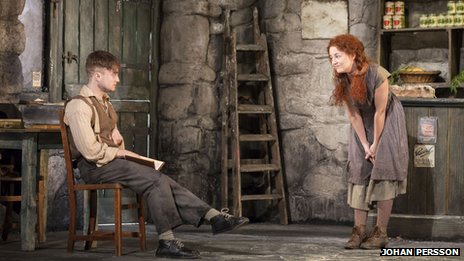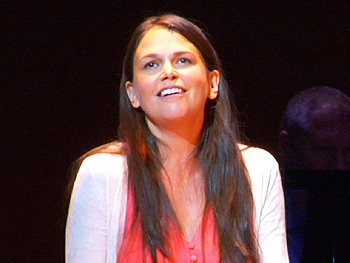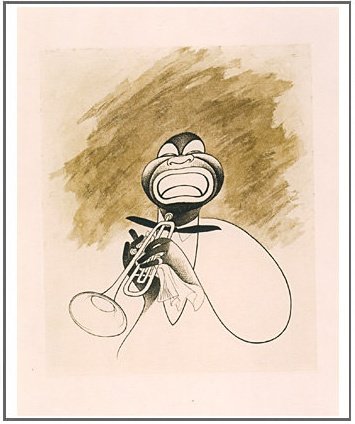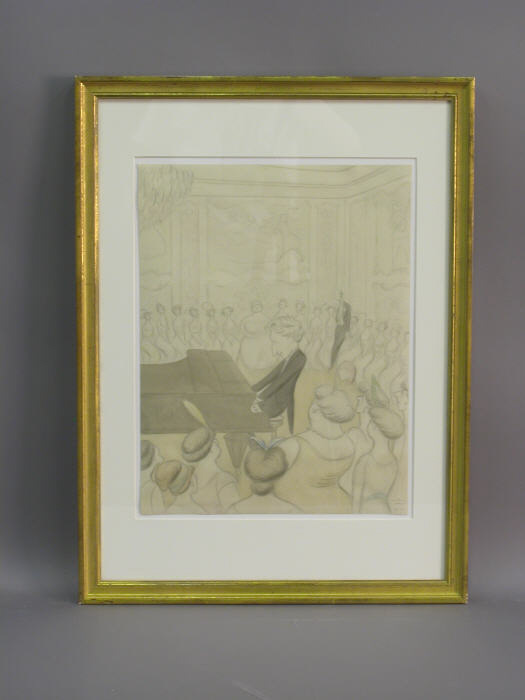“A nickname may be the best record of a success. That’s what I call putting the face of a joke upon the body of a truth.”
Joseph Conrad, Nostromo
Archives for 2014
Snapshot: Jerome Robbins’ Fancy Free
New York City Ballet dances Jerome Robbins’ Fancy Free in 1986. The score is by Leonard Bernstein:
(This is the latest in a series of arts-related videos that appear in this space each Monday and Wednesday.)
Almanac: George Meredith on caricature
“In fine, caricature is rough truth.”
George Meredith, The Egoist
The kid is alright
With the Broadway season thundering to a close, The Wall Street Journal has given me an extra column this week to cover all of the shows that are opening in time for the Tony Awards eligibility deadline. In today’s paper I review the Broadway premieres of The Cripple of Inishmaan, Violet, and The Velocity of Autumn. Here’s an excerpt.
* * *
Granted that it’s always a pleasure to see one of Martin McDonagh’s plays performed on Broadway, why mount “The Cripple of Inishmaan” there just five years after the Atlantic Theater Company imported a flawless all-Irish staging by Galway’s Druid Theatre that should have moved uptown but didn’t? As the millennials say, because Daniel Radcliffe. In the absence of the presence of the former Harry Potter, this production of Mr. McDonagh’s bitingly black 1996 comedy about the not-so-small cruelties of village life would never have transferred from London’s West End to the Cort Theatre, no matter how good it might be–and it’s very good. But so, too, is Mr. Radcliffe. He is, in fact, that rarest of birds, a child movie star who decided to turn himself into an adult stage actor, worked at his craft with modesty and dead-serious determination and has become an accomplished performer…
 If you don’t know “The Cripple of Inishmann,” you won’t have any doubts about Michael Grandage’s production, in which Mr. Radcliffe plays a severely handicapped teenage boy who can no longer stomach the good-humored but thoughtless teasing of his neighbors (it says everything about them that they all casually refer to him as “Cripple Billy”) and so removes himself to Hollywood to seek success in what the Irish call “fillums.” Mr. Radcliffe is so far inside his character that it actually took the audience a few tantalizing seconds to realize who he was when he made his first entrance on Saturday night….
If you don’t know “The Cripple of Inishmann,” you won’t have any doubts about Michael Grandage’s production, in which Mr. Radcliffe plays a severely handicapped teenage boy who can no longer stomach the good-humored but thoughtless teasing of his neighbors (it says everything about them that they all casually refer to him as “Cripple Billy”) and so removes himself to Hollywood to seek success in what the Irish call “fillums.” Mr. Radcliffe is so far inside his character that it actually took the audience a few tantalizing seconds to realize who he was when he made his first entrance on Saturday night….
If, on the other hand, you were fortunate enough to watch the Druids at work, you’ll see at once what’s missing this time around. Mr. McDonagh’s play is also a take-no-prisoners satire on the sentimental clichés of stage-Irishness, and Mr. Grandage, instead of emphasizing them (“Oi have me drunkard mammy to look after”) in order to make them self-evidently ludicrous, has mostly chosen to play them straight…
The Roundabout Theatre Company has revived “Violet,” the 1997 Brian Crawley-Jeanine Tesori musical about a North Carolina girl with an axe-scarred face (Sutton Foster) who rides a Greyhound bus to Oklahoma in the hope of being made beautiful by an Oral Roberts-type televangelist. It’s a sweet, unpretentious little show that doesn’t really belong on Broadway, but the wondrous Ms. Foster pours the whole of her soul into it, and her performance is radiant and true in all ways but one: She is the opposite of plain.
 Yes, the animating premise is that Violet’s inner beauty makes her outwardly lovely for those with eyes to see, but one grows tired of seeing pretty people cast in stage and screen roles that require them to pretend to be unattractive–especially when the script specifies, as is the case here, that the character’s disfigurement be invisible to the audience. Why not find an ordinary-looking but charismatic performer who can act beautiful?…
Yes, the animating premise is that Violet’s inner beauty makes her outwardly lovely for those with eyes to see, but one grows tired of seeing pretty people cast in stage and screen roles that require them to pretend to be unattractive–especially when the script specifies, as is the case here, that the character’s disfigurement be invisible to the audience. Why not find an ordinary-looking but charismatic performer who can act beautiful?…
Eric Coble breaks the U.S. record for clichés per minute in “The Velocity of Autumn,” his new cranky-codger two-character comedy. Near-senile old lady? Check. Estranged gay son with unfinished emotional business? Check. Hackneyed plot? Check. (Mom wants to go on living in her Brooklyn house, but the kids want to put her in a nursing home, so she barricades the front door, brandishes a Molotov cocktail and tells them to bring it on.) Tap-the-tendon punch lines interspersed with ephiphanic moments of pseudo-poetry? Check, check and octuple check….
* * *
Read the whole thing here.
Lookback: how I became a critic
From 2004:
A reader wrote to ask if I’d consider posting a list of books and other works of art that had served as “turning points” in my life as a critic. I’ve never drawn up such a list, though I once wrote an essay for the New York Times Book Review called “I’ve Got a Crush on You” (it’s in A Terry Teachout Reader) in which I talked about several authors whose styles I’d emulated at different times in my life. But what gave me the idea to become a critic–and what inspired me to become the kind of critic I became?…
Read the whole thing here.
Almanac: Macaulay on caricature
“The best portraits are those in which there is a slight mixture of caricature.”
Thomas Babington Macaulay, “Machiavelli”
A vision of joy
Al Hirschfeld, who adored jazz, drew Louis Armstrong for the first time in 1939 and continued to do so repeatedly throughout his long and productive life. One of the last occasions was in 1990, thirteen years before Hirschfeld’s death, when he did a portrait of the trumpeter called “Satchmo!” It is, in my opinion, the best of all possible Armstrong caricatures, one in which the joyous public figure whom the whole world loved is portrayed with a near-abstract simplicity of line that is not merely witty but beautiful.
I like “Satchmo!” so much that I used it as the last illustration in Pops: A Life of Louis Armstrong, accompanied by the following caption:
Many now feel ill at ease with the old-fashioned, crowd-pleasing entertainer portrayed in this 1990 caricature by Al Hirschfeld, but there was nothing false about Satchmo’s unselfconscious smile.
 Hirschfeld later turned “Satchmo!” into a limited-edition color lithograph that I saw when I went to the Margo Feiden Galleries six years ago to secure permission to reproduce the original drawing in my book, an experience that I blogged about here. I was bowled over by its richness and depth–it looked almost three-dimensional–and longed to buy a copy on the spot and add it to the Teachout Museum. Alas, the timing was financially unpropitious, and in due course I put the wild idea of owning a Hirschfeld out of my head.
Hirschfeld later turned “Satchmo!” into a limited-edition color lithograph that I saw when I went to the Margo Feiden Galleries six years ago to secure permission to reproduce the original drawing in my book, an experience that I blogged about here. I was bowled over by its richness and depth–it looked almost three-dimensional–and longed to buy a copy on the spot and add it to the Teachout Museum. Alas, the timing was financially unpropitious, and in due course I put the wild idea of owning a Hirschfeld out of my head.
That notion came back with full force, however, not long after Satchmo at the Waldorf opened in March. A fair amount of time had gone by since Mrs. T and I last added anything to our collection, and it seemed to both of us that the moment had arrived. I took a cab to the Margo Feiden Galleries last Thursday and returned home a few hours later with a pencil-signed copy of “Satchmo!” under my arm. I dropped it off at our framer over the weekend. We’ll hang it in our New York apartment as soon as we decide on the right spot.
I can’t imagine a more suitable way to celebrate the New York opening of Satchmo at the Waldorf, can you?
* * *
 Longtime readers of this blog will recall that “Satchmo!” is the second caricature to make its way into the Teachout Museum. It was preceded by a drawing of Percy Grainger by Max Beerbohm, which I acquired in 2004 and about which I blogged here and here:
Longtime readers of this blog will recall that “Satchmo!” is the second caricature to make its way into the Teachout Museum. It was preceded by a drawing of Percy Grainger by Max Beerbohm, which I acquired in 2004 and about which I blogged here and here:
Max makes a point of saying that a caricature should be executed in “the most beautiful manner,” and while it’s true that his Grainger caricature is very funny–especially the society ladies clustered around the piano, who range in size from wasp-waisted to preposterously portly–it’s also quite beautiful indeed. The composition is cunningly balanced, the line deft and clear, the light touches of watercolor wash miraculously subtle.
I mention this because I recently learned, purely by chance, of the existence of an art gallery in London that deals in Beerbohm caricatures. While none of them is of anyone who is still widely remembered, many are striking in their own right. So if, like me, you love Max’s work and long to hang a piece of it on your wall, go here to peruse the inventory.
Just because: Buster Keaton on This Is Your Life
Buster Keaton is the guest on a 1957 episode of Ralph Edwards’ This Is Your Life::
(This is the latest in a series of arts-related videos that appear in this space each Monday and Wednesday.)
